Address any questions or comments regarding this newsletter to the individual authors listed after each article or to its editors, Nathan Johanning, 618-939-3434, njohann@illinois.edu or Bronwyn Aly 618-695-6060, baly@illinois.edu. The Illinois Fruit and Vegetable News is available on the web at: http://ipm.illinois.edu/ifvn/. To receive or be removed from email notification of new postings of this newsletter, contact Nathan Johanning or Bronwyn Aly at the phone numbers or email addresses above.
In This Issue:
Upcoming programs (listings for beginning and established growers)
News & Announcements (Update on Local Foods Extension Educator Team)
Regional Reports (St. Louis metro east, southwestern Illinois (Waterloo), southern Illinois (Murphysboro), Dixon Springs)
Fruit & Vegetable Production & Pest Management (Pumpkin Disease & Insect Management, Cucumber Beetle Management, Watch Out For Cross-Striped Cabbage Worm, Evergestis rimoralis, Spotted Wing Drosophila – A 2021 Update for Berry Growers, Biological Insect Control in High Tunnels, Spotted Lantern Fly Found in Eastern Indiana)
Upcoming programs
See the University of Illinois Extension Local Food Systems and Small Farms Team’s website at:
http://web.extension.illinois.edu/smallfarm/ and the calendar of events at http://web.extension.illinois.edu/units/calendar.cfm?UnitID=629.
- 2021 Southern Illinois Summer Twilight Meeting Series, monthly evening meetings May-August at 6 p.m. After a year off, plans are underway to host IN-PERSON twilight meetings across southern Illinois during the 2021 growing season. For more information visit https://extension.illinois.edu/news-releases/2021-southern-illinois-summer-twilight-series or to register online directly, visit go.illinois.edu/2021TwilightSeries
- August 16, 2021 Bauman Family Farm, Vienna, IL – regenerative grazing in cattle production
- Purdue Small Farm Education Field Day and Webinar Series. In person Field Day July 29 at the Purdue Student Farm and Webinar Series August 2-13, 2021. For the full agenda, details and registration visit:https://www.purdue.edu/hla/sites/studentfarm/events/.
- Jackson County Grounds & Research Tour. August 12, 2021 6:00 -7:30 pm, Jackson County Extension Office 402 Ava Rd. Murphysboro, IL 62966. Spend the evening learning about the importance of tomato fertilization, exploring different production systems for specialty crops, and touring the 20’ by 48’ demonstration high tunnel. Other highlights of the program will include the native rain garden and a demonstration garden that features cutflowers and gourds. The tour is free but please RSVP by calling the office at (618) 687-1727 or visit www.go.illinois.edu/jacksontour
- The Great Lakes Fruit, Vegetable & Farm Market Expo (GLEXPO) is returning to its traditional face-to-face format, and will be held December 7-9, 2021 at the DeVos Place in Grand Rapids, Michigan. Registration for the program itself will be coming at a later date, but you should make your room reservations now as hotels near the conference site tend to fill up quickly. Visit their website for additional details as they become available at https://glexpo.com/expo-schedule/ or visit their Facebook page at https://www.facebook.com/GLExpo/
- Save the Date! The Illinois Specialty Crops Conference is also returning to a face-to-face format January 5-7 at the Springfield Crowne Plaza. Our program team is well on their way to providing another great program, so we should have program details available in the coming months.
News & Announcements
Update on Local Foods Extension Educator Team
The Local Food System and Small Farms Extension Educator team (listed on the last page of the newsletter) has seen some growth in the last year or two, with the addition of several new team members across the state. In this issue of the newsletter, we would like to send our best wishes to two of our team members that are entering into new chapters in their lives. Laurie George has taken a position with the Produce Safety Alliance as the Midwest Regional Extension Associate. Laurie will continue working with growers throughout the Midwest on food safety issues and FSMA trainings. And at the end of July, James Theuri will start his retirement journey! Both James and Laurie have worked many years helping the specialty crop growers across Illinois and we wish them much joy and happiness for their futures.
Regional Reports
St. Louis metro east… Rain came for all in the region, but with mixed response in terms of need, with the more southern areas happy to see it come while the northern collar county already had more than they needed. Temperatures have been warm, with some real heat in the forecast. Peaches and blackberries are in harvest, as well as sweet corn, tomatoes, and greens. Pumpkins are in the ground and are off to a good start. For the most part, the growing season is going well.
Elizabeth Wahle (618-344-4230; wahle@illinois.edu)
From southwestern Illinois (Waterloo)… We are currently in a “typical” southern Illinois summer weather pattern with highs about 90 and very hot and humid. We have had a couple of inches of rain about a week ago and had been in a very rainy pattern with lots of popup storms but this week that pattern has broke just and back to heat and humidity. Here in Monroe County most have had close to “ideal” precipitation over the last month especially compared with those to the north and also areas to the east. Parts of Perry County had reports of 10+ inches of rain last week in some areas with lots of flash flooding and water. Overall the dry weather pattern is appreciated.
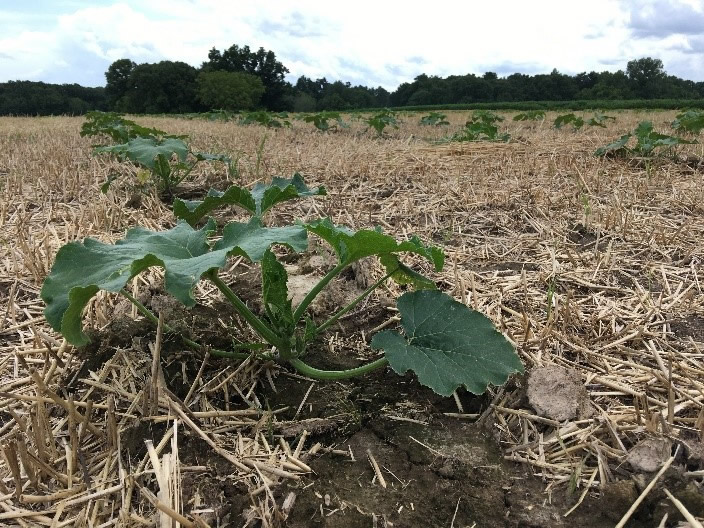
Pumpkin Crop 10 days after transplanting. Photo: N. Johanning
Crops are all off and growing well. We are now into freestone peaches and most everyone I have talked to has had a good peach crop this year. Most summer vegetable are doing well and harvest is really picking up. The pumpkin crop is off to a good start. I transplanted my own pumpkins around the 4th of July weekend. Soil moisture was good but they really took off after a rain. The pictures here show the growth over 10 days time. It will soon be time to think about sidedress nitrogen applications in pumpkins. Typically a pumpkin crop needs total N of 60-100 lbs of N much of this depends on your soil organic matter and how much the soil will provide naturally. Areas of higher organic matter in parts of Central and Northern IL would lean towards the lowered end of that range and lighter colored soils on the higher end. Too much N can push excess vine growth and delay fruit set so more it not always better, but you do want to support a healthy crop canopy. I have had multiple reports of high number of striped cucumber beetles in pumpkins and other cucurbits. See the article later in this issue from our entomologist on more details on management.
Another pest that I have seen a lot of is caterpillars on tomatoes and some on peppers. In our trials we have had a large amount of, first hornworms and later yellow striped armyworms. With few other insect pests at the moment I have been using Dipel (Bt product) versus some of the other pyrethroids or carbaryl. We have made two applications a week apart and have been happy with the results. I have also noticed many red lady bugs and am happy that I can preserve them to help keep aphids in check. Unfortunately, I have noticed a few stink bugs so I am probably going to have to change this management strategy but will hold out as long as I can. Remember to consult the Midwest Vegetable Production Guide any vegetable crop management recommendation.
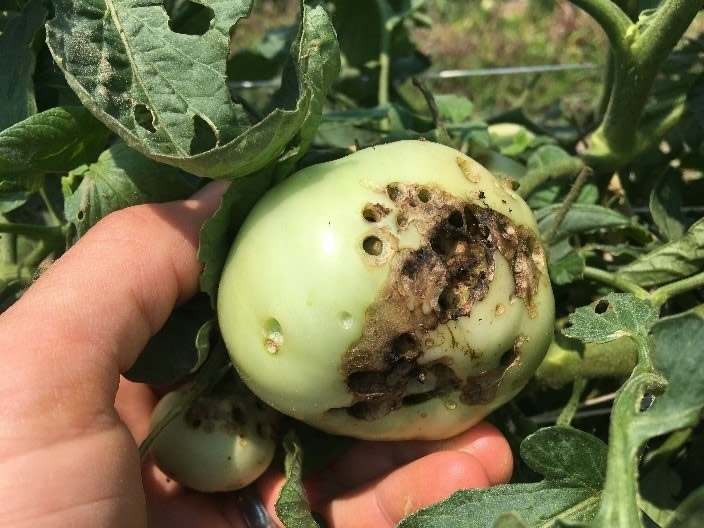

Severe fruit damage from yellow striped armyworm (left). Carcass from a tomato hornworm after an application of Bt (Dipel) (right). Photos: N. Johanning

Now is also the time to get started with some of those fall vegetable plantings. I have started broccoli and cauliflower on the first and middle of July for a fall crop. Starting some of these transplants can be a little challenging given the heat. They do not germinate well in high soil temperatures (especially over 80°F). I have learned to seed them and I keep them on the north side of a building out of most all direct sun until they start to emerge (usually about 3 days under good conditions). I then pull them out to a little more direct sun (but not full sun) if not they very quickly get leggy. I work them out to more sun that first week ad from there mainly have them in full sun to harden off. Caterpillars are also very problematic on cole crops even just as young transplants. I have found that again a Bt product such as Dipel works very well. I mix up a small amound in a quart spray bottle and have sprayed the oldest ones twice now with good results.
Fall broccoli and cauliflower transplants planted July 1 (left) and July 17 (right). Photo: N. Johanning
Nathan Johanning (618-939-3434; njohann@illinois.edu)
From southern Illinois (Murphysboro)… It seems like the summer is flying by, and a lot has happened since June. We went through a hot dry spell shortly after the pumpkins were no-till transplanted into the field around the 24th of June. They are starting to vine out and flower after the rain we received lately. The past few weeks we went from not having enough rain, to flood conditions in many of the lower areas.
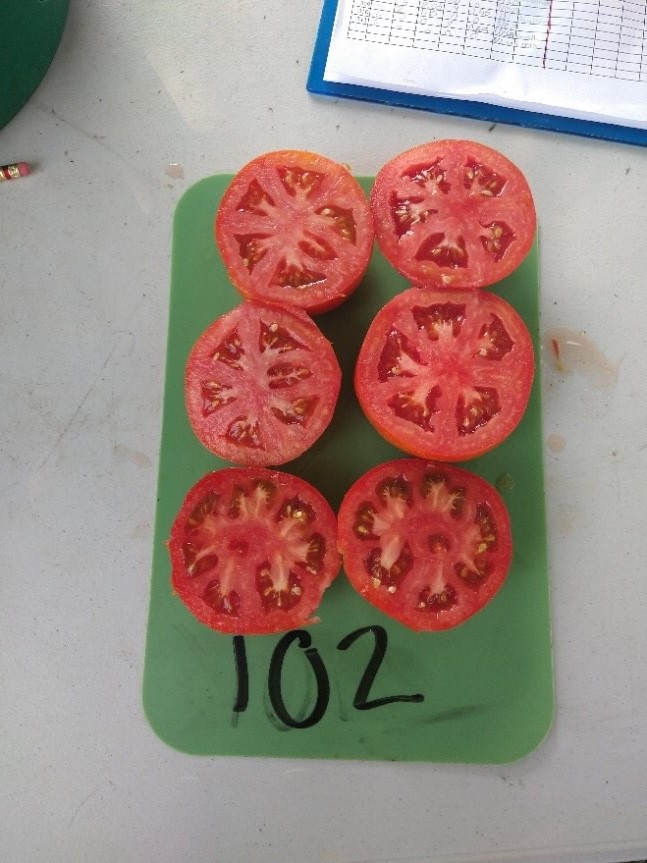
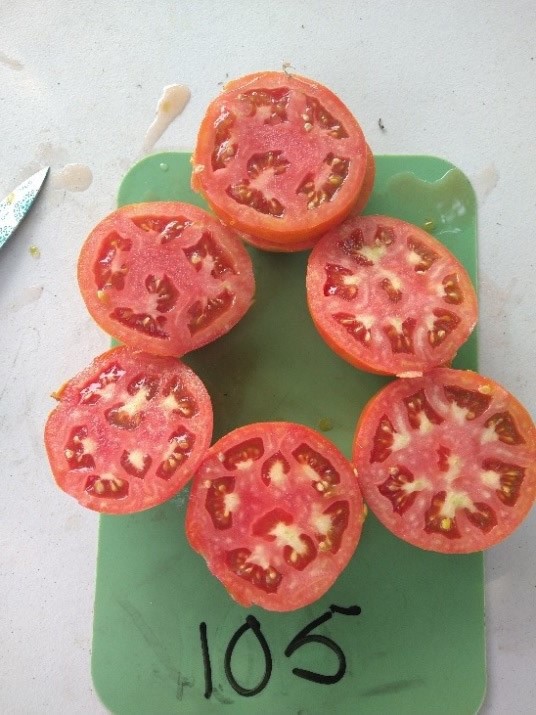
Tomato fruit quality from the fertility trial. Photo: K. Bell
The fertility trial tomatoes have been harvested twice now, starting on July 14th. Looking at the green fruit on the plants we can expect the following harvests to be quite large. So far, we are seeing some differences between treatments based on the first replication’s fruit which were cut and photographed. We also noticed a difference in some of the middle plots across all three replications, which may be due to field drainage issues. The middle plots were observed to have stunted plants and smaller fruit. This does not appear to be a result of the fertilizer treatments because it’s occurring in all three replications across very different nutrient rates, ranging from water only to 20 lbs per acre of K2O5. The following pictures are comparisons from the most fertilized (102) with a pre-plant fertilizer and a twice a week feeding of potassium nitrate at a rate of 20 lbs per acre of K2O5 per week, and the least fertilized (105) which received no pre-plant and no additional fertilizer. We are still early in the harvesting, and I am excited to see what our results will look like after a few more harvests.
The High Tunnel is still going strong and we are getting many of our slower growing fall crops seeded for transplants. Also, around the Jackson county office we have been experimenting with a trellis/tunnel to grow smaller gourds and snap beans. Several varieties of ornamental gourds were direct seeded, including snake gourds and mini bottle gourds. The demonstration gardens also showcase cut flowers, herbs, and several types of squash.

Gourd and snap bean tunnel. Photos: K. Bell
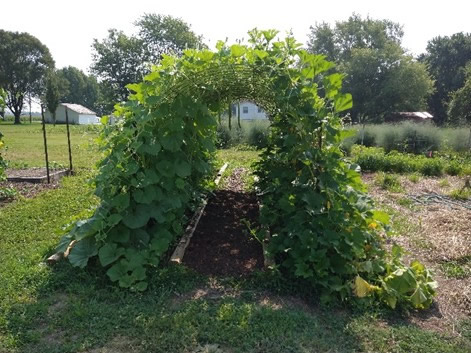
As always have a happy and safe 2021 growing season!
Katie Bell (618-687-1727; klbell@illinois.edu)

Bronwyn Aly and Kacie Athey sharing information during the twilight meeting at DSAC. Photo by H. Willis.
From Dixon Springs Ag Center…Since our last newsletter update, we hosted the second 2021 Southern Illinois Summer Twilight Meeting at DSAC. Participants were able to tour the different high tunnels and learn about the ongoing insect pest management research involving biological control with natural insect predators. Dr. Athey discussed the research project as well as showed examples of different high tunnel insect pests. The tomato fertility study was also highlighted during the meeting.
Along with the thrips, aphids and mites that are typically found in high tunnel production systems, we have also needed to control for tomato hornworm and armyworm in all the tunnels. Stinkbug damage has been noted on a few tomato plots in the fertility study but thankfully the damage has been limited to one tunnel so far. We have applied a couple of fungicide sprays to the tomato and pepper plots but only as a preventative measure due to the high summer humidity and amount of growth on the plants.
This week we are in the middle of extremely heavy harvests from all three varieties of tomatoes in the fertility study. We are cutting tomatoes from the different treatment plots to give a rating on the amount of white core present. One observation that we have made from this trial is that ‘Mountain Gem’ seems to be a light feeder. It doesn’t take as much fertilizer for this variety to grow a lot of foliage compared to the other two varieties, and it appears to have very little incidence of white core. A formal update from this project will be provided during winter meeting season and will include analyzed yield data, not just observations.
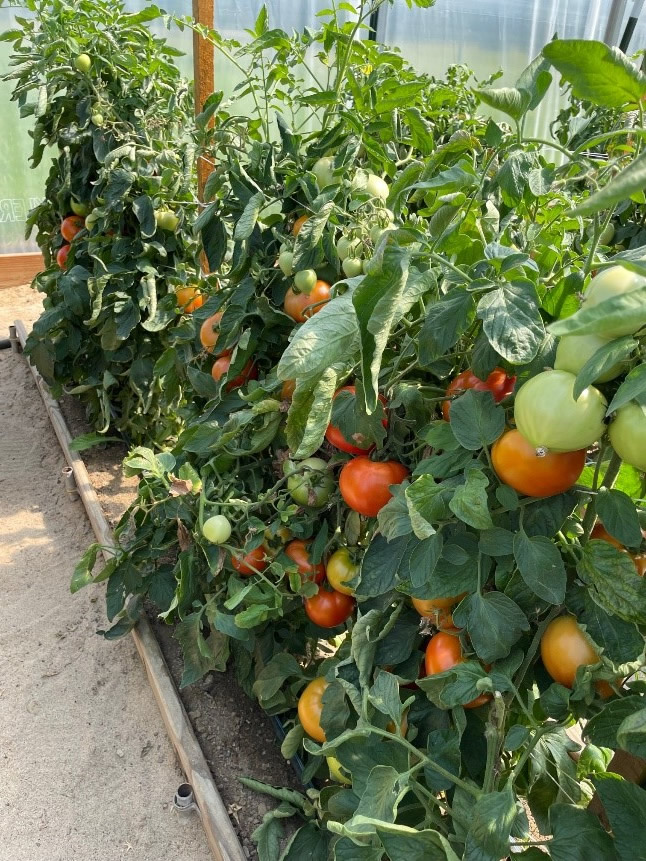
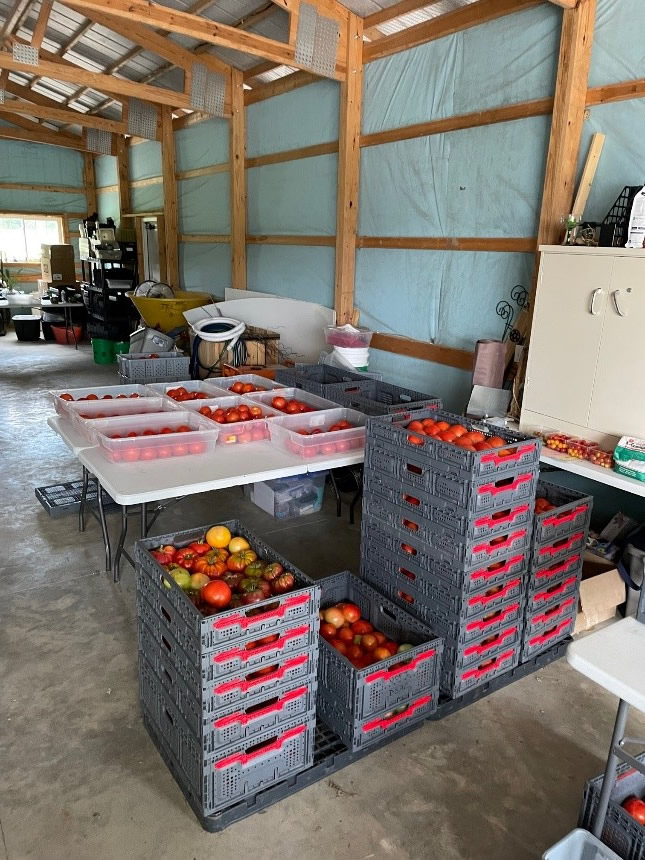
Left: Loaded tomato plots in tomato fertility plot at DSAC. Right: One day’s tomato harvest (~500 lbs) from tomato fertility plots at DSAC. Photos by B. Aly
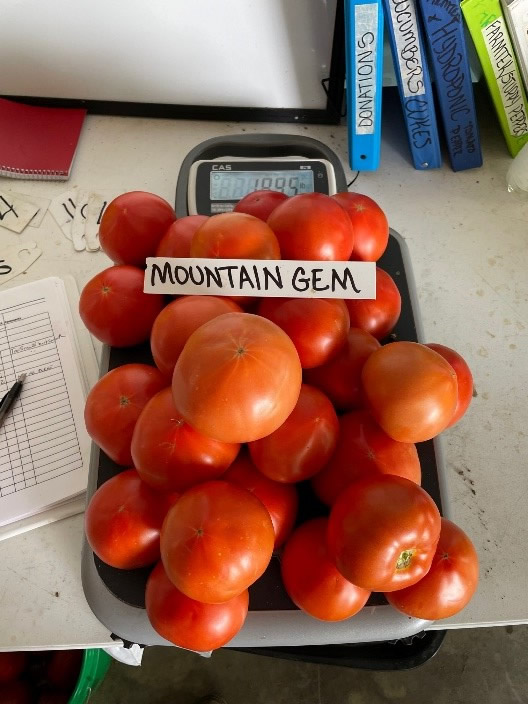
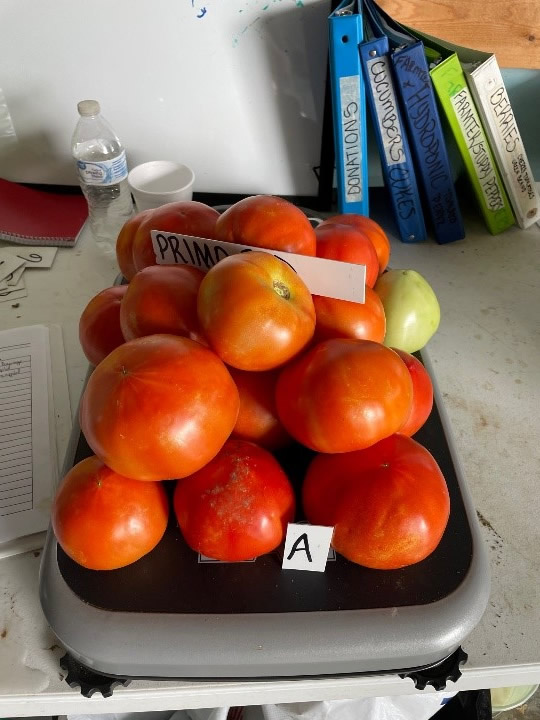
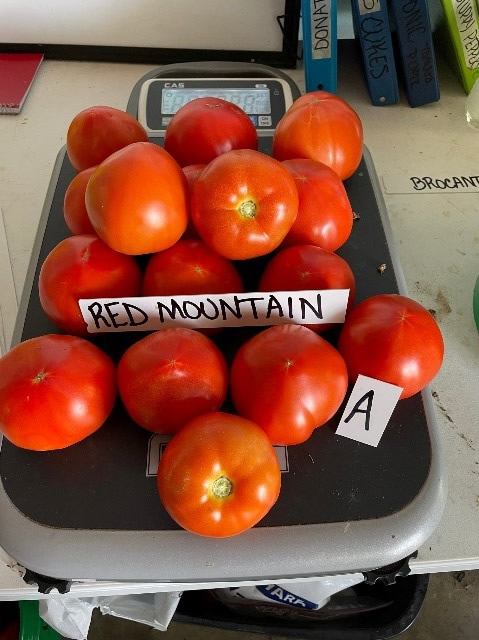
Left to Right: ‘Mountain Gem’, ‘Primo Red’, and ‘Red Mountain’ number 1 grade tomatoes being weighed as part of the data collection for the tomato fertility trial at DSAC. Photos by B. Aly.
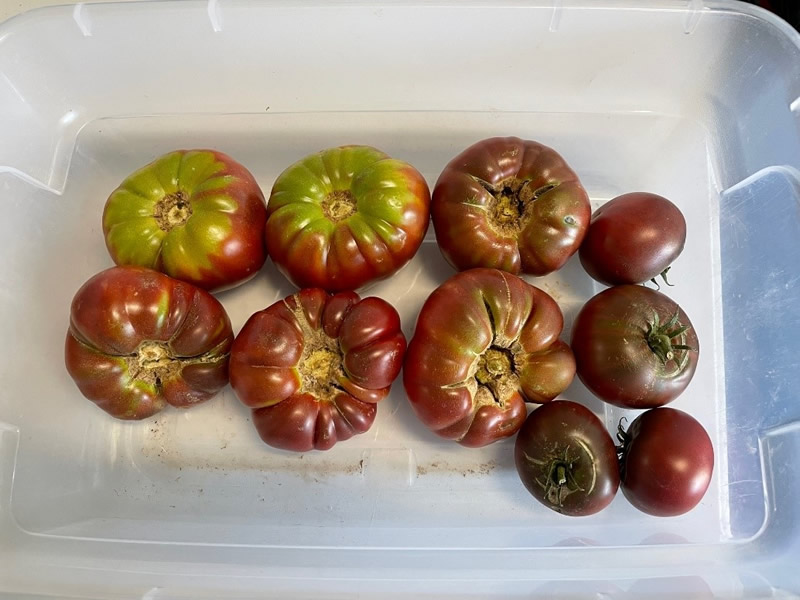
‘Marnouar’ tomato fruit grown in high tunnels at DSAC. Photo by B. Aly.
In a comparison of ‘Marnouar’ tomato from two different high tunnel production systems at DSAC, the six fruit on the left side of photo were grown in soil in raised beds with fertilizer delivered through the drip irrigation line. The four fruit on the right side of the photo were grown hydroponically. Besides the somewhat similar color, these fruits would appear to be from two different varieties. The size and shape of the fruit is VERY noticeably different between the two production systems, as well as the stem and core. This was just an interesting observation that we noticed this season, and I think it serves as a good reminder of the importance of trialing varieties on a small scale with your individual production systems before committing a large portion of your production area to a new variety. A variety that may work well under one growing system may perform completely different in a location with a variation in growing conditions.
Bronwyn Aly (618-382-2662; baly@illinois.edu)
Fruit & Vegetable Production & Pest Management
Pumpkin Disease & Insect Management
As we get into the later part of July, now is the time to start scouting more closely for diseases and insects in pumpkins. Powdery mildew is by far the most prevalent and common pumpkin disease, but also bacterial spot and also in some years downy mildew can also blow into the area. However, I have not heard of any reports yet of downy mildew in any cucurbits in the region as of now. Cucumber beetles and squash bugs are the most prevalent insect issues, along with aphids occasionally.
Our entomologist, Dr. Kacie Athey has a great article below in this issue on cucumber beetle control. For additional insects recommendations would refer to the Midwest Vegetable Production Guide for products and thresholds or contact Dr. Athey (contact information below with the article). We can tolerate some insect presence and still no have enough damage to warrant spraying an insecticide. ALWAYS scouts for insects versus just throwing in the insecticide with every fungicide spray. Often you do not need an insecticide that frequently, so you are wasting money on the product. Additionally, if you over spray you can often eliminate natural predators of aphids and then end up with aphid issues. This then means you must add yet another product ($$) to manage them in addition to the extra insecticide you applied which got you to this point in the first place. On my own farm usually, I can get away easily with using an insecticide every other fungicide spray and sometimes less than that.
When applying insecticides in pumpkins always spray them in the late afternoon, evening, or after dark to help preserve our pollinators. Most pumpkins flowers are closed by this time and also bee activity decreases. Early in the morning is probably the worst time. That day’s flowers are opened and bees are very active with the first light of the day, even before sunrise.
To catch powdery mildew early, we want to be scouting the vines and also undersides of leaves which is where it often shows up first. For best control, start a preventative fungicide program, before or as soon as any infection is noted in the field. Often late July or early August is when we would expect to see infections start.
Please see the link below for the current, 2021 pumpkin fungicide recommendations from the research our plant pathologist Dr. Mohammad Babadoost for all of these common pumpkin diseases
https://extension.illinois.edu/sites/default/files/pumpkin_spray_recommendations_for_2021.pdf
For more information or questions about pumpkin disease management contact Dr. Babadoost at 217-333-1523 or babadoos@illinois.edu
Nathan Johanning (618-939-3434; njohann@illinois.edu)
Cucumber Beetle Management
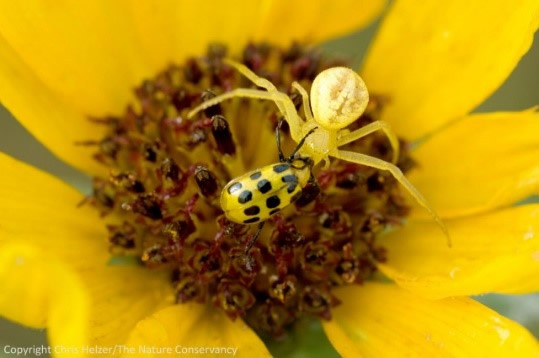
Spider ambushing a spotted cucumber beetle
There seems to be a larger number of striped and spotted cucumber beetles this year in Illinois compared to previous years. It is important to control these beetles as they transmit the pathogen that causes bacterial wilt (Erwinia tracheiphila). This disease has no cure and once the plant gets it, it will eventually die. Cucumbers, muskmelons, and summer squash are more vulnerable to bacterial wilt than pumpkins, but among pumpkin cultivars, processing pumpkins are more susceptible than Jack-o-Lantern pumpkins. Additionally, watermelon is not very susceptible to bacterial wilt.
Controlling cucumber beetles is the only way to prevent this disease and so it is important to keep them under control. Around this time of year, it is also important to control beetles as they will feed on ripening fruits which can make the fruit less marketable, even if the beetles are not spreading bacterial wilt to your particular field.
The thresholds for control are 1 beetle for plant in cucumber, muskmelons, summer squash, and processing pumpkins and 5 beetles per plant in watermelon and Jack-o-lantern pumpkins.
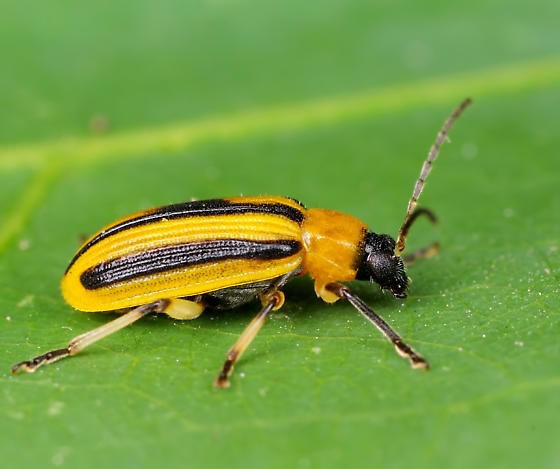
Striped cucumber beetle ©Scott Justis, bugguide.net
For organic growers, Azera® has the best documented efficacy for cucumber beetle control. You may need to reapply every three days under heavy infestations as this insecticide has a short residual and beetles will quickly recolonize plants.
For conventional growers, Sevin® and Assail® have proven effective this season in Illinois. As always, be very careful around bees. Assail is very toxic to bees and as such, should be sprayed very late in the day and avoid spraying flowers whenever possible.
The 2021 Midwest Vegetable Production Guide for Commercial Growers lists several other insecticides that are labeled for cucumber beetle control. I have included a link here to the online guide that allows you to pick your crop and pest resulting in a list of insecticides you can use. https://mwveguide.org/ There is also a PDF if you prefer.
Kacie Athey (217-244-9916; kathey@illinois.edu)
Watch Out For Cross-Striped Cabbage Worm, Evergestis rimoralis

The Cross-Striped Cabbage Worm starts out small and green, but after digging into leafy-garden goodness, thin black and white stripes develop across its back (pictured here). It was last reported in Illinois Fruit and Vegetable News in 2020 - https://ipm.illinois.edu/ifvn/contents.php?id=161
The same insecticides used to control other "worms" in these crops (Bt, Coragen, Radiant, and pyrethroids) are also effective against cross-striped cabbageworm (IFVN, 24:15, 2018). See the 2021 Midwest Vegetable Production Guide for a more complete listing of insecticides by crop. It is available for downloading here: https://vegcropshotline.org/article/the-midwest-vegetable-production-guide-for-commercial-growers-2021-id-56/
Be sure to follow spray application directions and pre-harvest intervals where harvests are coming up or ongoing. Photo: J. Theuri
James Theuri (815-933-8337; jtheu50@illinois.edu)
Spotted Wing Drosophila – A 2021 Update for Berry Growers
Kathy Demchak, Dept. of Plant Science, Penn State Univ. efz@psu.edu
This is the time of year when spotted wing drosophila populations can rapidly increase in Pennsylvania, making efforts to control this pest a necessity for most berry crop growers.
Updated info can be found through The Sustainable Spotted Wing Drosophila Project web site, found at https://swdmanagement.org/ . If you haven’t found this web site, take some time when you can to browse the site, and see what is there.
Of particular interest to many growers is the insecticide efficacy ranking compiled by this group. Ratings are provided by project entomologists, growers and crop consultants with experience with spotted wing drosophila from across the country and are compiled by Phillip Fanning (Univ. of Maine) and Rufus Isaacs (Michigan State Univ). The article summarizing the results and other important points can be found here: https://swdmanagement.org/wp-content/uploads/2021/05/SWD-rankings-document-2021.pdf The article includes a graph that makes relative efficacy rankings easy to see, and a second graph that color-codes products by chemical class to make it easy to rotate chemistries. Rotating product chemistries is important, as resistance has already been found in some spotted wing drosophila populations.
It should be noted that some of the rankings are based on limited data, and sometimes there is variation in the ratings assigned by different contributors. If no error bar appears on top of the vertical bar indicating efficacy for a particular product, that means that only one rating was received. If the error bar is large, this is an indication of variability in how well different contributors thought the product worked, so the rating should be taken with a “grain of salt”. A small error bar means more consensus in the rating.
As a supplement to the information provided on the project web site, an updated table appears below that also lists active ingredients of each product rated, IRAC codes, berry crops on which these products can be used on, and the days-to-harvest and re-entry intervals for each.
Note that spotted wing drosophila does not appear on the labels of all products listed; when that is the case, whether the material can be used for spotted wing drosophila depends on regulations in each state. Not all products are registered for use in all states. If from outside of PA, consult the label and your state’s registrations for products that may be used in your location. (R) following the pesticide name indicates that the material is a restricted-use pesticide.
Ranking in graphs |
Rating* |
Product Name |
Active Ingredient(s) |
IRAC code (chem. class) |
Pre-harvest interval (d = days; h = hours; --- = not labeled for use on this crop). See individual product labels for details |
Re-entry interval (h = hours; d = days) |
|||
|
|
|
|
|
|
|
|
|
|
|
|
|
|
|
Strawberry |
Brambles |
Blueberries |
Ribes |
|
|
|
|
|
|
|
|
|
|
|
1 (limited data) |
E (limited data) |
Cormoran |
novaluron + acetamiprid |
15 + 4A |
1d |
--- |
8d (highbush); 1d (lowbush) |
8d |
12h |
2 |
E |
Lannate (R) |
methomyl |
1A |
--- |
--- |
3d |
--- |
48h for blueberries |
3 |
E |
Mustang Maxx (R) |
zeta-cypermethrin |
3A |
--- |
1d |
1d |
1d |
12h |
4 |
E |
Danitol (R) |
fenpropathrin |
3A |
2d or 3d (see label) |
3d |
3d (highbush); 2d or 3d (lowbush) |
21d currants; 3d gooseberry |
24h |
5 |
E |
Imidan |
phosmet |
1B |
--- |
--- |
3d |
--- |
24h highbush; 3d lowbush |
6 |
E-G |
Diazinon (R) |
diazinon |
1B |
5d |
--- |
7d |
--- |
5d blueberry; 3d strawberry |
7 |
E-G |
Asana (R) |
esfenvalerate |
3A |
--- |
7d |
14d |
--- |
12h |
8 |
E-G |
Verdepryn |
cyclaniliprole |
28 |
1d |
1d |
1d |
1d |
4h |
9 |
E-G |
Brigade (R) |
bifenthrin |
3A |
0d |
3d |
1d |
1d |
12h |
10 |
E-G |
Exirel |
cyantranili-prole |
28 |
1d |
1d |
3d |
3d |
12h |
11 |
E-G |
Malathion |
malathion |
1B |
3d |
1d |
1d |
1d currants; 3d gooseberry |
12h |
12 |
E-G |
Delegate |
spinetoram |
5 |
--- |
1d |
1d or 3d |
1d or 3d |
4h |
12** |
E-G |
Radiant** |
spinetoram |
5 |
1d |
--- |
--- |
--- |
4h |
13 |
E-G |
Hero (R) |
zeta-cypermethrin + bifenthrin |
3A + 3A |
--- |
3d |
1d |
--- |
12h |
14 |
G |
Entrust |
spinosad |
5 |
1d |
1d |
3d |
3d |
4h |
15 |
G |
Baythroid XL (R)*** |
beta-cyfluthrin |
3 |
--- |
--- |
--- |
--- |
12h |
16 |
F |
Apta |
tolfenpyrad |
21A |
1d**** |
1d**** |
3d**** |
3d**** |
12h |
17 |
F |
Assail |
acetamiprid |
4A |
1d |
1d |
1d |
1d |
12h |
18 (limited data) |
F (limited data) |
Spear-T |
GS-omega/kappa-Hxtx-Hv1a |
32 |
0d |
0d |
0d |
0d |
4h |
19 |
F |
Sevin |
carbaryl |
1A |
7d |
7d |
7d |
7d |
12h |
20 |
F |
Grandevo |
Chromobac-terium subtsugae strain PRAA4-1T and spent fermentation media |
not |
0d |
0d |
0d |
0d |
4h |
21 |
F |
Movento |
spirotetramat |
23 |
--- |
--- |
7d |
7d |
24h |
22 (limited data) |
F (limited data) |
Pyganic |
pyrethrins |
3A |
0d |
0d |
0d |
0d |
12h |
23 |
F-W |
Veratran D*** |
Sabadilla alkaloids |
not applic. |
--- |
--- |
--- |
--- |
12h |
24 |
F-W |
Altacor |
chlorantranili-prole |
28 |
--- |
3d |
1d |
1d |
4h |
25 |
F-W |
Venerate CG |
Heat-killed Burkholderia |
UnB |
0d |
0d |
0d |
0d |
4h |
26 |
F-W |
Azera |
azadirachtin + pyrethrins |
Un + 3A |
0d |
0d |
0d |
0d |
12h |
27 |
W |
Jet-Ag |
hydrogen peroxide + peroxyacetic acid |
not applic. |
not spec. |
not spec. |
not spec. |
not spec. |
Until sprays dry in field; 4h in greenhouses |
28 |
W |
Azaguard |
azadirachtin |
Un |
0d |
0d |
0d |
0d |
4h |
29 |
W-N |
Rimon |
novaluron |
15 |
1d |
--- |
8d highbush; 1d or 8d lowbush |
8d |
12h |
30 |
W-N |
Sivanto |
flupyradi-furone |
4D |
see label |
0d |
see label |
see label |
4h or 12h (see label) |
31 |
W-N |
Admire Pro |
imidacloprid |
4A |
7d (foliar); 14d (soil) |
3d (foliar); 7d (soil) |
3d (foliar); 7d (soil) |
3d (foliar); 7d (soil) |
12h |
*E = excellent, G = good, F = fair, W = weak, N = Little to no efficacy
**Radiant was not rated in the original document, but was assigned the same ranking as Delegate based on active ingredient.
***Baythroid is not labeled for berry crops but may be used on cherries and grapes. Veratran D is not allowed for use on any berry crops, but is labeled for use on certain crops grown in warm climates.
****As of this writing, directions for use on berry crops appear only on supplemental labels.
This article was reprinted in the IFVN with permission from the author.
Biological Insect Control in High Tunnels
Kacie Athey, Specialty Crops Entomologist Department of Crop Sciences, University of Illinois
Greenhouse pests you would expect to find in high tunnels including spider mites (A), aphids (B – C), whiteflies (D), and thrips (E – F).
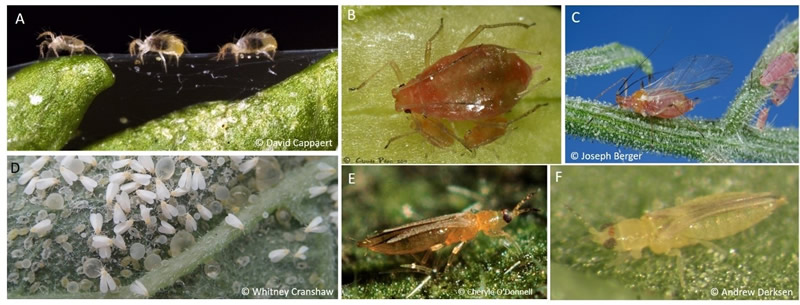
Biological control is defined as the suppression or prevention of a pest outbreak due to the purposeful manipulation of natural enemies. Biological control is considered environmentally safe. It can be quite effective with some successes, including its uses in greenhouses. It is also considered cost effective as it can have great potential for return for a small investment. It also can reduce the reliance on chemical insecticides. There are several types of biological control, but in high tunnels, augmentative biological control is commonly used.
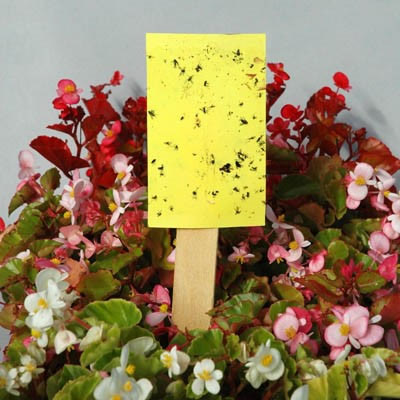
© harrisseeds
For using augmentative biological control, the key is prevention. Biological control agents often work slowly to decrease pest numbers so you want to control pests early in the season when the numbers are low. You want to take action before the pest exceeds a threshold and especially before they get to an economic injury level. This requires early monitoring and intervention. Biological control is useful against regular or predictable pests. It should also be noted that predators can have different levels of effectiveness depending on the plant.
The first step is to identify the pest and determine its population size. To detect early infestations, a crop scouting program that includes both sticky trap cards (usually yellow) and visual inspection is critical. Scouting should be done once a week, and more often after an infestation is detected. Regular scouting is also necessary to monitor the efficacy of control measures. A hand lens is a useful tool to detect live pests as well as signs of pest activity. e.g., frass (feces), cast skins, honeydew, etc.
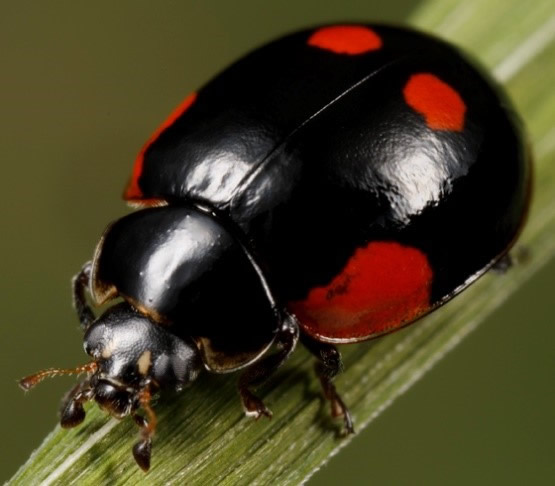
Adalia bipunctata, a predator of aphids. Photo © Joyce Gross
There are many commercially available predators that can be easily purchased (https://entomology.ca.uky.edu/ef125). There are two types of augmentative biological control: inundation, release large numbers of predators that overwhelm the pests and provide a quick knockdown effect and inoculation, release a small number of predators in the early season allowing the predator to reproduce through a season and keep the pest numbers low. Inundation is more common for predators.
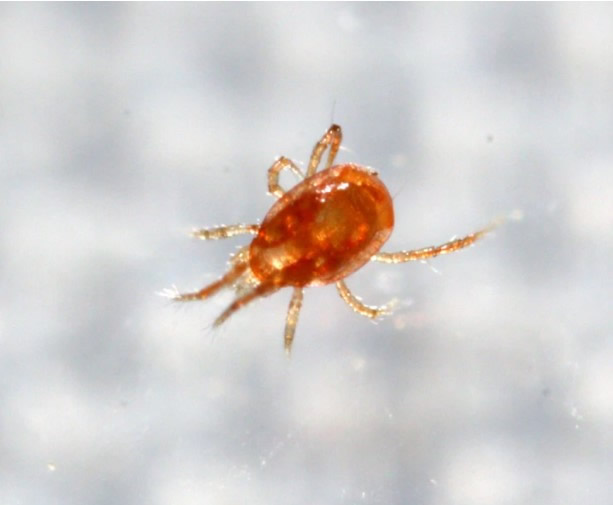
Amblyseius swirskii, a predator of thrips and spider mites. Photo©biobugz.com
There are important considerations for using predators. Because these are living organisms that you are using, their quality is going to affected by shipping and storage. The predators that you order may need to acclimate to the environmental conditions of your greenhouse or high tunnel before release.
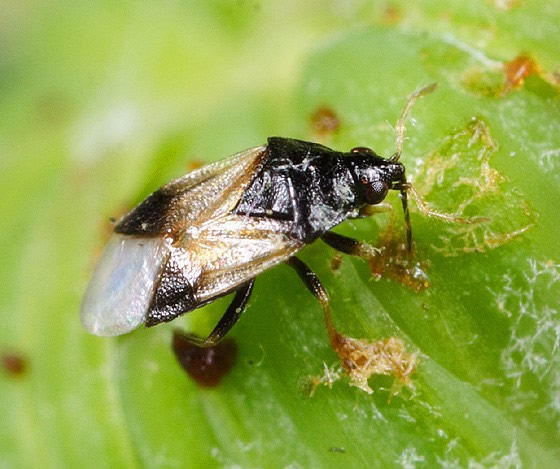
Orius insidiosus, a generalist predator. Photo ©Scott Justis
There are many questions you could ask of the vendors before you decide on the specific predator you would like to order. Will the predators be shipped directly from the insectary where they were raised? If they are not, how long are they stored before shipment? You want to ask how they are shipped. For example, some predators are shipping in containers that appear to be full of sawdust, some predators are shipped as eggs and some as adults. You can ask what they will look like when they get to you and how can you tell what the quality is? And maybe more importantly, what are the best practices for a successful release? Many vendors will have some of this information on their websites. So as far as success goes, one of the main ways to make biological control successful is to start it when pest numbers are low. If numbers are already out of control, this may not be an appropriate control method.
Kacie Athey (217-244-9916; kathey@illinois.edu)
Spotted Lanternfly Found in Eastern Indiana
The invasive spotted lanternfly (Lycorma delicatula) was recently found for the first time in Switzerland County, Indiana (Eastern Indiana), the farthest west the insect has been found. Please see this article from the Indiana Department of Natural Resources for more details:
https://www.in.gov/dnr/entomology/pests-of-concern/spotted-lanternfly/
It is in a far eastern county, but it is steadily moving towards Illinois. It will likely be a pest for grape growers as well as a pest in landscapes. For more pictures and more details on this pest check out this factsheet: https://extension.illinois.edu/sites/default/files/spotted_lanternfly_fact_sheet_v8.pdf
Kacie Athey (217-244-9916; kathey@illinois.edu)
Less Seriously
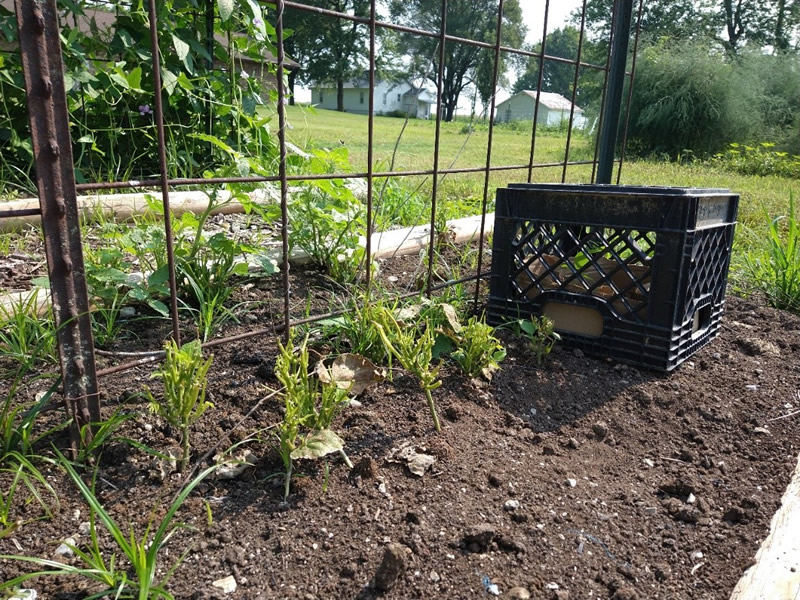
This summer the Jackson County office has been taken over by rabbits. They are everywhere from popping unexpectedly out of the flower beds to running stealth missions into the High Tunnel to steal veggies. The peas and green beans are their snack of choice at the moment, and in order to protect the lone blue pea plant in the gourd tunnel certain security measures have been taken.
I realize that protecting all our crops with a milk crate or cage is not usually a feasible, but this is a good example of how annoying and damaging rabbits and rodent pests can be. I think our current rabbit issue is a good reminder of why it is important to control excess weeds and potential cover around your production areas. (Photo: K. Bell)
-KB
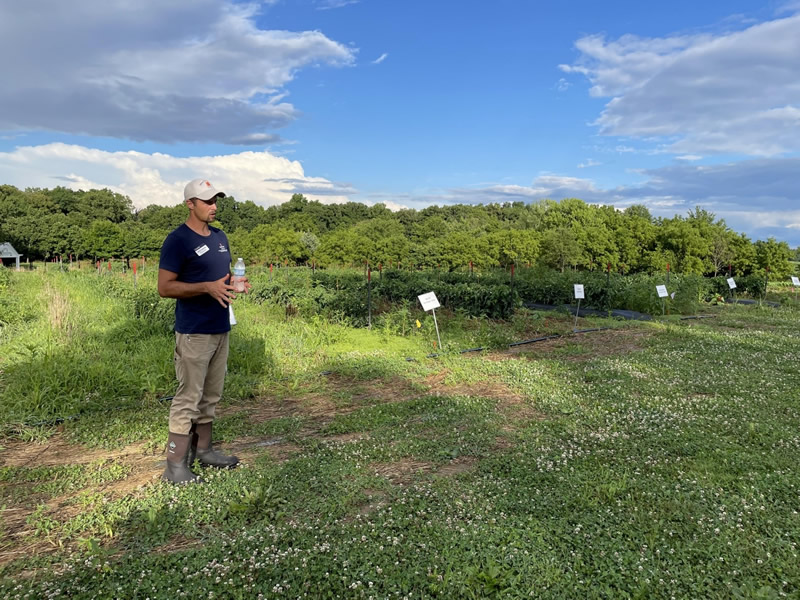
Do you know how to tell if the educator presenting information at a meeting is full of it?
…
Look at their feet, if they are the only person wearing muck boots and it isn’t a program on livestock or manure, you might need to do a bit of fact checking! -BA
…in my defence it JUST had stopped rain! 😊 -NJ
Photo by B. Aly.
University of Illinois Extension Specialists in Fruit and Vegetable Production & Pest Management
Extension Educators – Local Food Systems and Small Farms |
||
Bronwyn Aly, Gallatin, Hamilton, Hardin, Pope, Saline, and White counties |
618-382-2662 |
|
Katie Bell, Franklin, Jackson, Perry, Randolph, & Williamson counties |
618-687-1727 |
|
Sarah Farley, Lake & McHenry counties |
847-223-8627 |
|
Nick Frillman, Woodford, Livingston, & McLean counties |
309-663-8306 |
|
Laurie George, Bond, Clinton, Jefferson, Marion, & Washington counties |
618-548-1446 |
|
Zachary Grant, Cook County | 708-679-6889 | |
Doug Gucker, DeWitt, Macon, and Piatt counties |
217-877-6042 |
|
Erin Harper, Champaign, Ford, Iroquois, and Vermillion counties |
217-333-7672 |
|
Grace Margherio, Jackie Joyner-Kersee Center, St. Clair County |
217-244-3547 |
|
Grant McCarty, Jo Daviess, Stephenson, and Winnebago counties |
815-235-4125 |
|
Katie Parker, Adams, Brown, Hancock, Pike and Schuyler counties |
217-223-8380 |
|
Kathryn Pereira, Cook County |
773-233-2900 |
|
James Theuri, Grundy, Kankakee, and Will counties |
815-933-8337 |
|
Extension Educators – Horticulture |
||
Chris Enroth, Henderson, Knox, McDonough, and Warren counties |
309-837-3939 |
|
Richard Hentschel, DuPage, Kane, and Kendall counties |
630-584-6166 |
|
Andrew Holsinger, Christian, Jersey, Macoupin, & Montgomery counties |
217-532-3941 |
|
Extension Educators - Commercial Agriculture |
||
Elizabeth Wahle, Fruit & Vegetable Production |
618-344-4230 |
|
Nathan Johanning, Madison, Monroe & St. Clair counties |
618-939-3434 |
|
Campus-based Extension Specialists |
||
Kacie Athey, Entomology |
217-244-9916 |
|
Mohammad Babadoost, Plant Pathology |
217-333-1523 |
|